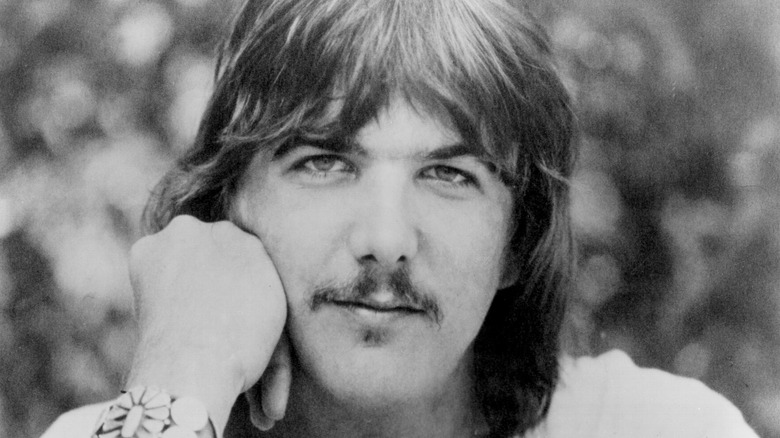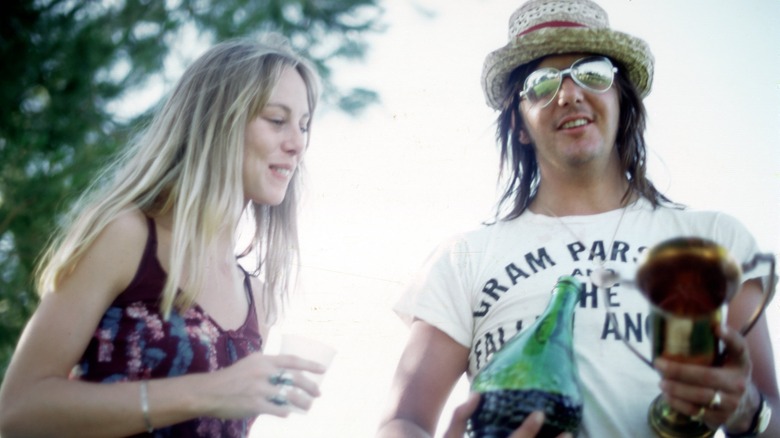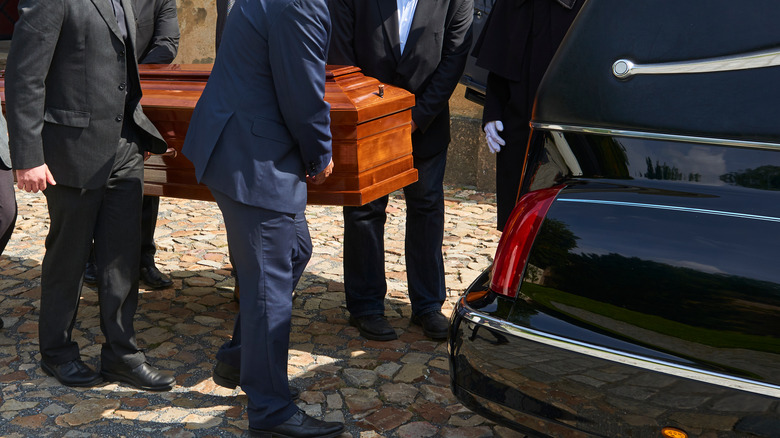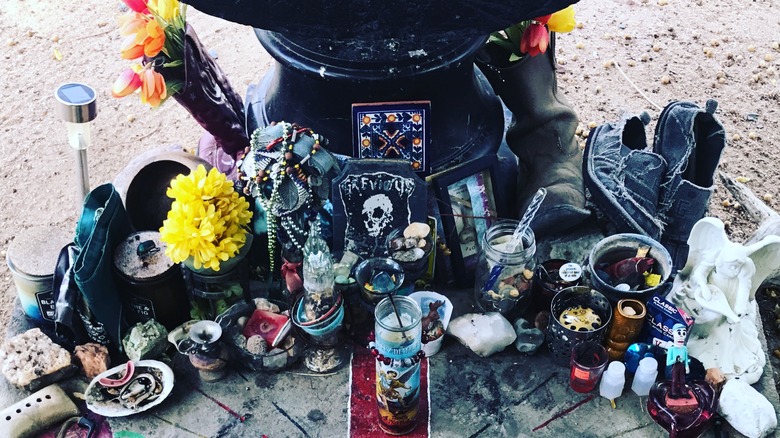The Tragic And Bizarre 1973 Death Of Gram Parsons
Gram Parsons was an influential musician who died far too young. As a singer-songwriter, he changed country and rock music forever, per The Los Angeles Times. And after his death at age 26, his friends helped accomplish his final wishes with an unforgettable desert funeral.
Gram Parsons recorded two albums in 1968, according to New Georgia Encyclopedia. One with his college band, the International Submarine Band. Next, he played piano for The Byrds, and their highly-praised album, "Sweetheart of the Rodeo," was primarily attributed to Parson's influence on the band. Riding the success of the album, the band was the first rock group to be invited to perform at the Grand Ole Opry. But they quickly annoyed organizers when they played one of Parson's songs instead of a pre-approved Merle Haggard song. Parsons then got on his bandmate's nerves when he insisted on staying in England to party with friends instead of traveling to the next concert in South Africa. The Byrds fired Parsons.
He bounced back, forming the Flying Burrito Brothers band, and releasing back-to-back albums with them in 1969 and 1970. But that band also fired him: according to Taste of Country, his heavy drug use was a big contributing factor in the decision to kick him out of the band.
For the next three years, Parsons continued to write acclaimed songs, work with other singers, and release solo albums. But he also had a consistent drug habit that he tried and failed to quit.
His partying got him into trouble
As a young rock and roller with a tendency to party hard, Gram Parsons reportedly drank heavily and used heroin (per Rolling Stone). By 1973, he had been kicked out of numerous bands for his unruly drug habits. He loved to spend time in the Joshua Tree town, and "he knew every bar and saloon in the area," according to another of Parsons' managers, Ed Tichner.
In September 1973, Gram Parsons and his friends spent a weekend at the Joshua Tree Inn. For the most part, they just relaxed and didn't appear to be partying hard. Parsons was going through a divorce, but those around him said he seemed to be coping well, drinking minimally, and he was writing several songs every day.
But the owner of the hotel remembered that Parsons looked pale, according to Rolling Stone. Per "Twenty Thousand Roads," one September night, Parsons allegedly was willingly injected with liquid morphine by a woman referred to as simply "the connection" while also taking barbituates, assorted pills, and drinking whiskey. After his first dose, he asked for another.
Parsons died from an overdose
The woman who had injected him with the morphine fled the room as soon as Parsons started overdosing, according to "Twenty Thousand Roads," Another woman named Margaret was with Parsons and had also been injected with one dose of morphine. She said she and a third woman worked to revive him but eventually around midnight some other friends came home from getting food and alerted the hotel owners who called an ambulance, per Rolling Stone.
One hotel owner, Margaret Barbary, gave Parsons mouth-to-mouth resuscitation before he was rushed to a nearby hospital. But it was too late, and on September 19, 1973, Gram Parsons was declared dead at age 26, per Taste of Country. The official cause of death was declared to be "multiple drug use," pointing to a potent mixture of alcohol and morphine that killed the singer (via History).
After his death, his friend remembered a pact they had made after a friend's funeral that if either of them died the other would take their dead friend's body to Joshua Tree and burn it, as told in "Twenty Thousand Roads." He didn't want to have a traditional burial with mourners. Byron Berline said he heard Parsons say, "I'm not going through this crap. Take me out to the desert and burn me. Just burn my body." Many others would confirm this conversation.
The 'Gram Theft Parsons' plan
Gram Parson's stepfather apparently wanted to bury the musician in New Orleans, Louisiana, and he didn't want any of Parson's friends to be invited to mourn him (via Rolling Stone). Parson's friends didn't like that. And so began operation "Gram Theft Parsons," as his friend, manager — and the man Parsons made the death pact with, Phil Kaufman — phrased it.
To make Parson's final wishes a reality, Kaufman and roadie Michael Martin obtained an old hearse from Martin's girlfriend, according to History. The hearse didn't have a license plate, and the windows were cracked, but Kaufman and Martin dressed up in suits and attempted the plan anyway. The idea was to travel to the airport and grab Parson's remains before his family could fly the body to Louisiana.
It was ambitious: they planned to tell security that the Parsons family had actually changed their mind and that they had been sent to retrieve the remains. The two men went to the Los Angeles International Airport, where they knew Parson's body was waiting for the flight. Incredibly, Kaufman and Martin successfully removed Parson's remains from the airport, signing the name "Jeremy Nobody" on a slip of paper.
Gram Parsons' final resting place
After duping the airport security, they drove the remains to Joshua Tree National Park. Then, per New Georgia Encyclopedia, Phil Kaufman and Michael Martin drove to Cap Rock and used gasoline to light Parson's coffin on fire, fulfilling the musician's last wishes to be honored in the desert he loved.
Surprisingly, stealing a dead body wasn't actually a crime in California, so Kaufman was charged with the coffin theft. Taste of Country reports that Kaufman had to pay a $750 fine. So to raise money, he threw a "Kaufman's Koffin Kaper Koncert," which paid both his fine and an official burial for Gram Parsons in Louisiana.
Since his death, fans have been leaving mementos or messages, both at the inn where he died and at Joshua Tree National Park. According to Billboard, in 2001 there was a push from fans who wanted Gram Parsons to have a memorial plaque or an official area dedicated to him in the desert, but initially, the park declined. Today, people can visit the Joshua Tree National Park's Cap Rock and Gram Parsons Nature Trail, according to 10 Adventures. Fans still make the pilgrimage.




